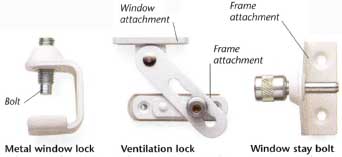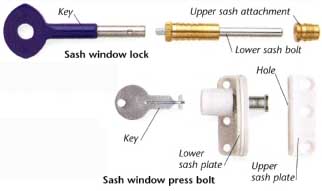Particularly popular in southern states, sliding glass doors—often called sliders or sliding patio doors—offer a view and direct access to backyards and decks. However, they also provide an easy point of entry for intruders unless they are properly installed. There are several reasons for this. First, their usual position at the back of a house makes sliding glass doors susceptible to burglars, who can remain hidden and undetected while they try to gain entry. Second, they are often left open during the spring and summer months, allowing easy access to backyard activities. Even if you follow the security steps mentioned below, you should still be mindful of closing and locking your sliding doors when they aren't in use.
However, the main reason for security problems is that some sliding doors are offered with only latches installed on them. These latches aren't as secure as locks, and can allow your sliding door to be easily removed. When sliding doors are installed, they need to be lifted and placed in their track. If your sliding doors aren't secured, or only secured with a latch, a burglar can actually lift one of the glass panels back out of the track to gain entry into your home. There are several methods to make sure your sliding glass door is secure.
Key locks
Sliding glass doors should have a strong, working key lock. A deadlock, which utilizes a bore pin tumbler cylinder and is operated by a key from the outside, is a good option. The lock bolt should engage the strike sufficiently so that it will not be disengaged by any amount of movement.
Securing doors in place with screws
Use sheet metal screws to secure the door in place through the track. Insert screws into the top of the door frame, at each end and in the middle. The screws should make the door movement tight, so that the door barely clears them.
Charley bars
Manufacturers often offer a block or bar that folds down from a unit to secure the doors in place. This device helps prevent the door from being opened, and should be used in addition to a locking system.
Dowel in the track
You can insert a dowel or pin in the track of the sliding door to prevent the door from being shoved aside or lifted off the track. It is important that the wooden dowel runs the whole length of the track.
Window Security
Modern windows often have security features built into their design. This may range from locking fasteners to multi-point mortise locks that are operated automatically as the window is secured shut. The items shown here are additional features that may be used as secondary security options for windows.

Metal window lock: Bolt screws down into the stay of the casement window.
Ventilation lock: Allows casement window to be locked open for ventilation. With window attachment.
Window stay bolt: Screws over the stay on casement or pivot windows. With frame attachment.

Casement window lock: Two-part lock for sealing casement windows. with window attachment and frame attachment.
Window screw bolt: Two parts engage when casement is closed. Secured with key-operated screw. Sash window lock: Fits through both sections of sash; when aligned, the bolt is screwed into place. Key; Upper sash attachment; Lower sash bolt.

Sash window press bolt: Plates align when sash window closes; the bolt is pressed into place. Key; Lower sash plate; Upper sash plate; Hole
Installing a Casement Window Lock

A. With the window closed, use an awl to mark positions for the striking plate on the frame and the locking body on the casement.
B. Drill pilot holes in the casement if necessary and then secure the locking body in place.
C. Layout and mark the position for the striking plate and drill pilot holes where needed. Screw the striking plate in place on the window frame.
D. Close the window and check the two parts of the lock meet, using the supplied key.